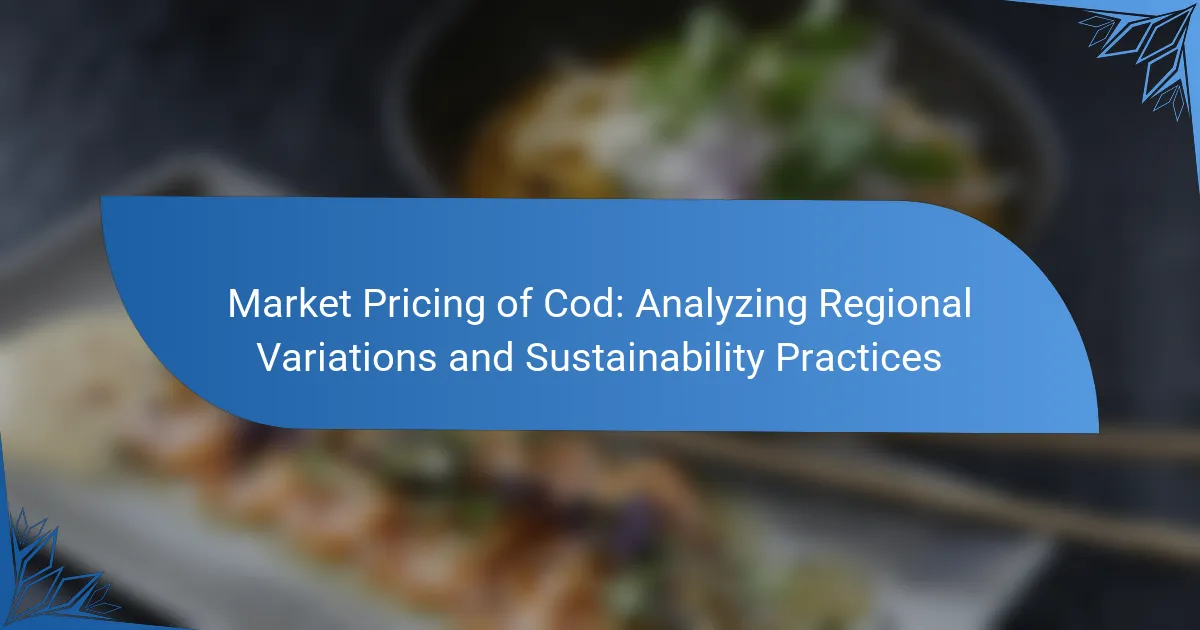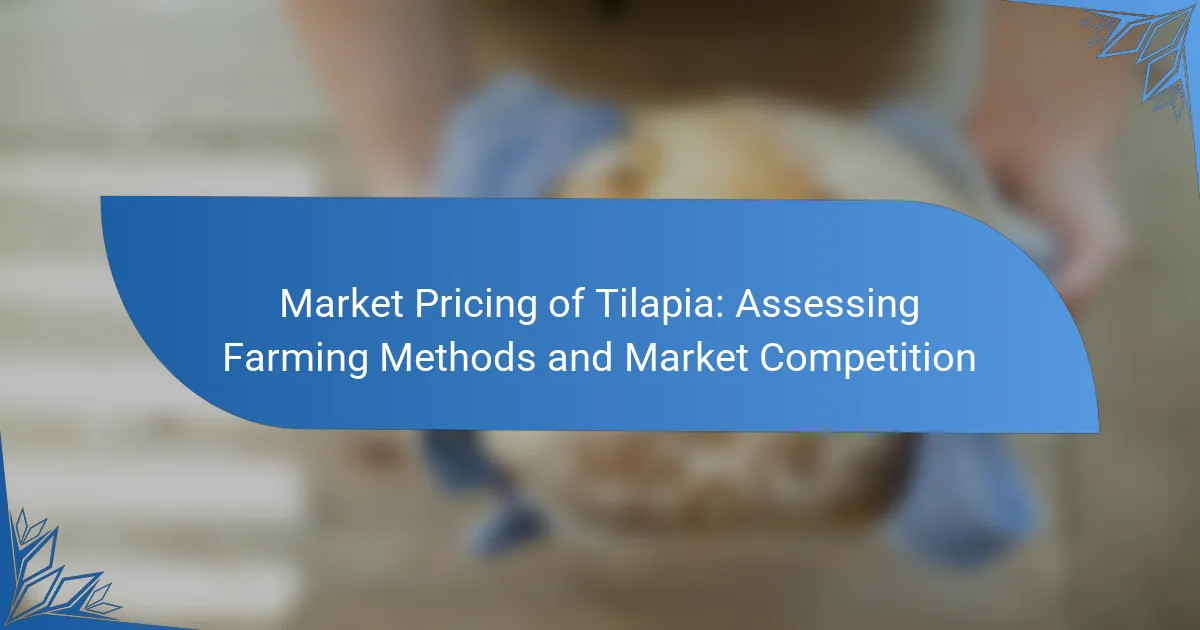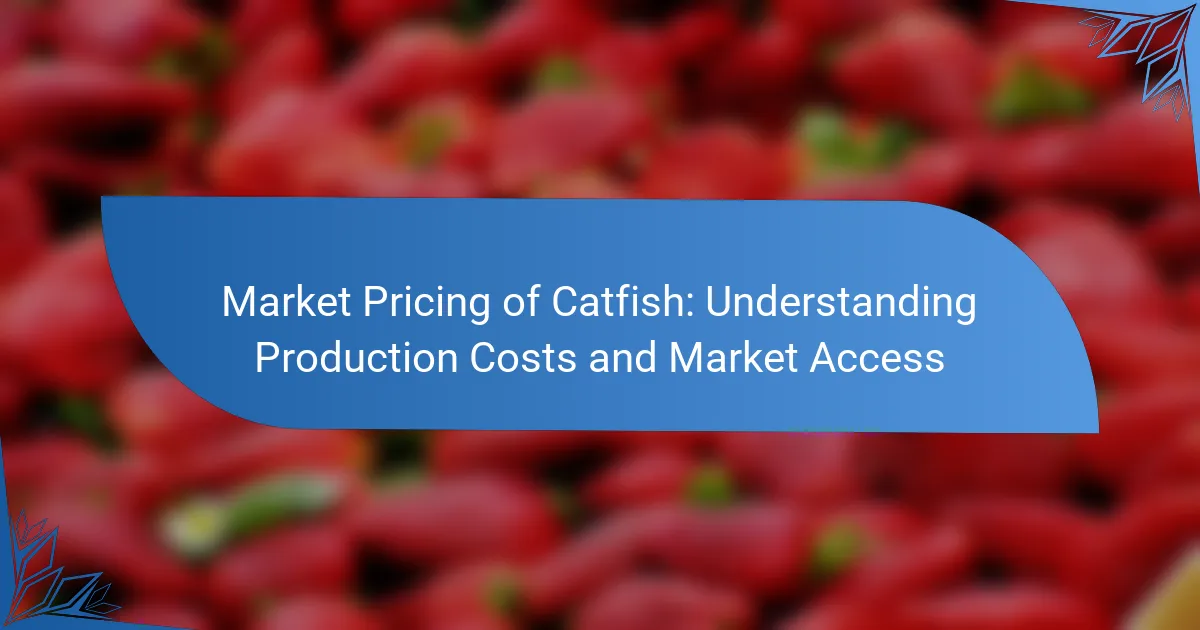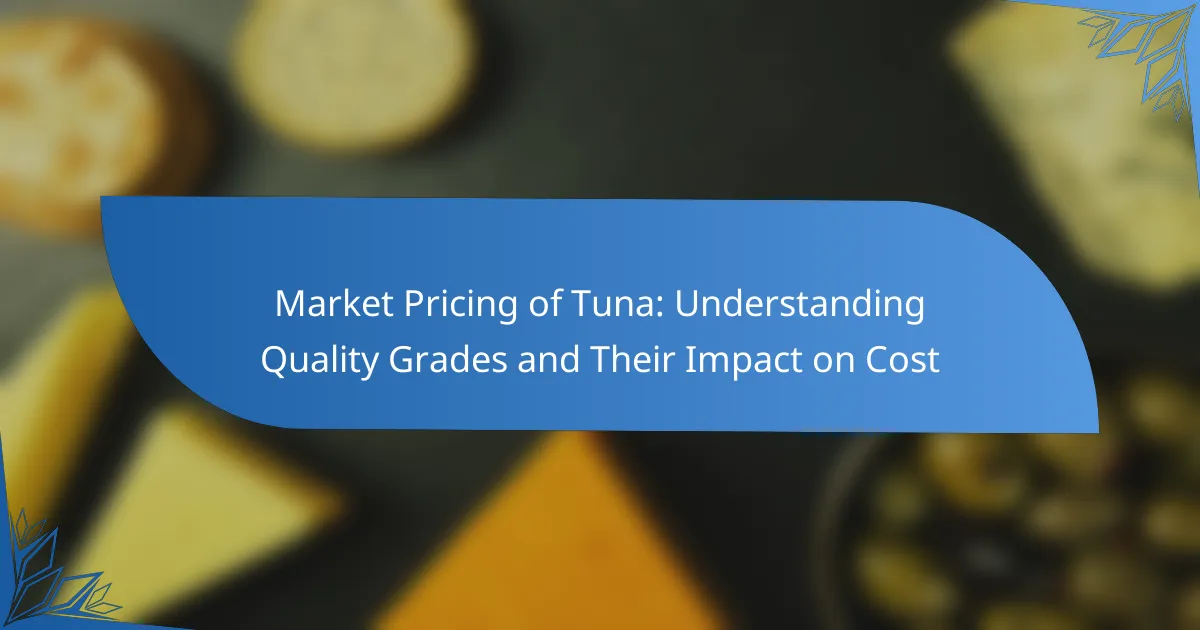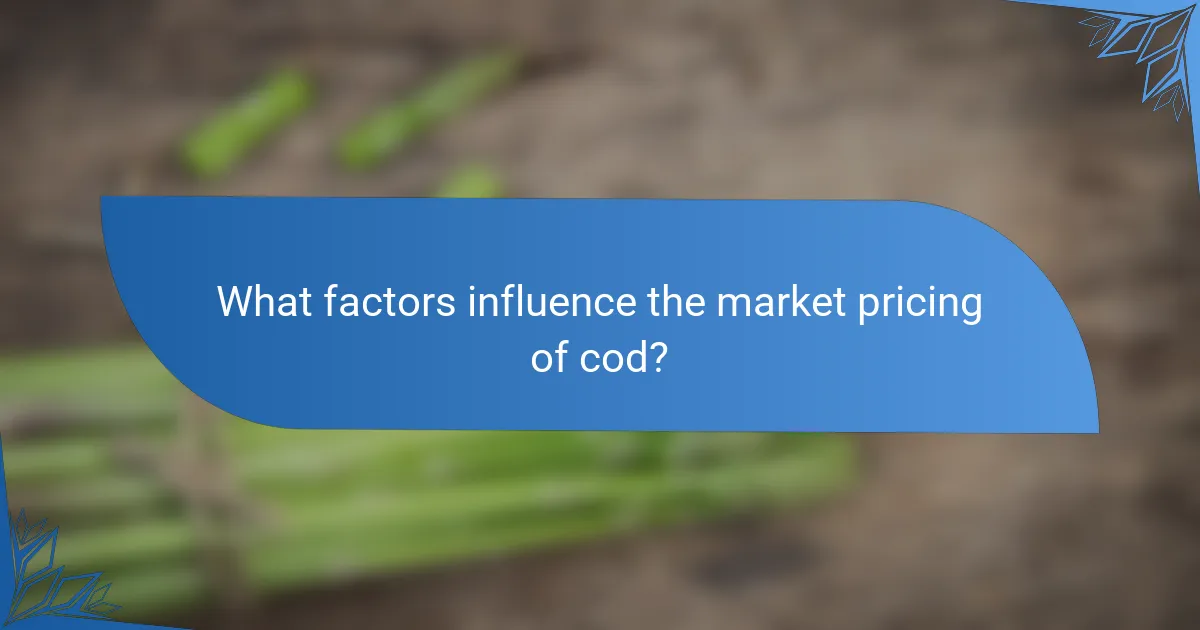
What factors influence the market pricing of cod?
The market pricing of cod is influenced by several factors. Supply and demand dynamics play a crucial role. When cod supply is high, prices tend to decrease. Conversely, limited supply can drive prices up. Seasonal variations also impact availability and pricing. For instance, cod is often more abundant during certain times of the year, affecting market rates.
Regulatory measures, such as fishing quotas, can restrict catch levels. These regulations aim to ensure sustainability but can lead to higher prices if catch limits are low. Additionally, consumer preferences influence pricing. A growing demand for sustainably sourced fish can increase prices for certified cod.
Geopolitical factors also affect market pricing. Trade agreements and tariffs can alter import and export costs. Lastly, transportation costs impact the final price. Fluctuations in fuel prices can lead to increased shipping expenses, which are often passed on to consumers.
How do regional variations affect cod pricing?
Regional variations significantly affect cod pricing due to differences in supply and demand dynamics. Regions with abundant cod stocks typically experience lower prices. Conversely, areas facing overfishing or stricter regulations may see higher prices due to limited supply. Seasonal factors also contribute; for example, prices can rise during off-peak fishing seasons. Additionally, local consumer preferences influence pricing; regions with high demand may command premium prices. Geographic factors, such as distance from fishing grounds to markets, affect transportation costs, impacting final prices. Reports indicate that cod prices can vary by as much as 30% between regions, reflecting these diverse influences.
What are the primary regions involved in cod fishing?
The primary regions involved in cod fishing include the North Atlantic Ocean, particularly around Newfoundland, Norway, and Iceland. These areas are known for their rich cod stocks. The Barents Sea is another significant region for cod fishing, especially for Atlantic cod. The Gulf of Maine also contributes to cod fishing activities. Historical data shows that these regions have been traditional fishing grounds for centuries. Regulations in these areas aim to promote sustainable fishing practices.
How does local demand impact cod prices in different regions?
Local demand significantly impacts cod prices in different regions. When demand increases in a specific area, prices tend to rise due to limited supply. Conversely, low demand often leads to decreased prices as sellers attempt to attract buyers. For instance, regions with a high consumption of cod, such as coastal communities, may experience elevated prices during peak fishing seasons. In contrast, inland areas with less demand may see lower prices. According to the National Oceanic and Atmospheric Administration, regional variations in demand can create price discrepancies of up to 20% or more. Overall, local demand plays a crucial role in shaping the market dynamics of cod pricing across various regions.
What role do sustainability practices play in cod pricing?
Sustainability practices significantly influence cod pricing. These practices often lead to higher operational costs for fisheries that implement them. Sustainable fishing methods can reduce overfishing and promote long-term fish stock health. This can result in increased supply stability, affecting market prices positively. Additionally, consumers are increasingly willing to pay a premium for sustainably sourced cod. Reports indicate that sustainably certified fish can command prices up to 20% higher than non-certified counterparts. Overall, sustainability practices create a market dynamic that can elevate cod prices due to consumer demand and responsible sourcing.
How do sustainable fishing methods affect market prices?
Sustainable fishing methods generally lead to higher market prices for fish. This occurs due to increased operational costs associated with sustainable practices. For example, sustainable fishing often requires more selective gear and longer fishing trips. These factors can reduce the overall supply of fish in the market. As a result, the reduced supply can increase prices. Additionally, consumers are increasingly willing to pay a premium for sustainably sourced seafood. Studies indicate that fish labeled as sustainably caught can command prices up to 30% higher than conventionally sourced fish. Therefore, sustainable fishing methods can create a price premium in the market.
What certifications influence consumer perception and pricing of cod?
Certifications that influence consumer perception and pricing of cod include Marine Stewardship Council (MSC) and Aquaculture Stewardship Council (ASC). MSC certification indicates sustainable wild-caught fish practices, appealing to environmentally conscious consumers. ASC certification signifies responsible aquaculture practices, which also attracts consumers prioritizing sustainability. Research shows that products with these certifications often command higher prices due to perceived quality and ethical sourcing. For example, a study from the University of Florida found that MSC-certified cod can sell for up to 20% more than non-certified counterparts.

Why is understanding cod pricing important for consumers and businesses?
Understanding cod pricing is crucial for consumers and businesses because it directly impacts purchasing decisions and profitability. Consumers benefit from knowing price fluctuations, which can indicate quality and sustainability. Businesses rely on accurate pricing to manage costs and set competitive rates. In 2021, the average price for cod in the U.S. was approximately $4.50 per pound, reflecting supply and demand dynamics. Awareness of these pricing trends helps consumers make informed choices and encourages businesses to adopt sustainable practices. Furthermore, understanding regional pricing variations can enhance market strategies and improve supply chain efficiency.
What are the economic implications of cod pricing variations?
Cod pricing variations significantly impact local economies and fishing industries. Fluctuations in prices can lead to changes in fishermen’s income. Higher prices may encourage increased fishing activity, while lower prices can reduce profitability. Regional differences in cod pricing can affect market access for small-scale fishers. Economic implications also extend to consumers, influencing purchasing decisions based on price changes. According to the Food and Agriculture Organization, cod prices can be affected by supply and demand dynamics. Additionally, price variations can impact fishery management policies and sustainability practices. These factors collectively shape the economic landscape surrounding cod fishing.
How do fluctuations in cod prices impact local economies?
Fluctuations in cod prices significantly impact local economies, particularly in coastal regions dependent on fishing. When cod prices rise, fishermen often experience increased income, leading to greater spending in local businesses. This can boost employment in sectors like retail and services. Conversely, when prices fall, fishermen may face financial strain, resulting in reduced spending and potential job losses. Historical data from the Northwest Atlantic Fisheries Organization indicates that price drops can lead to a 20% decline in local economic activity. Thus, cod price volatility directly correlates with the economic stability of fishing communities.
What are the potential consequences for businesses relying on cod?
Businesses relying on cod face several potential consequences. Overfishing has led to declining cod populations, which can result in stricter regulations. These regulations may limit catch quotas, impacting supply and profitability. Increased operational costs may arise from compliance with sustainability practices. Additionally, consumer preferences are shifting towards sustainable seafood. This change can affect demand for cod, leading to reduced sales. Market fluctuations due to environmental factors can also create instability in pricing. Businesses may face reputational risks if associated with unsustainable practices. Overall, reliance on cod poses significant risks to long-term viability in the seafood market.
How does consumer awareness of sustainability affect cod pricing?
Consumer awareness of sustainability increases cod pricing. When consumers prioritize sustainable fishing practices, demand for certified products rises. This demand encourages suppliers to adopt sustainable methods, leading to higher operational costs. Sustainable practices often result in lower catch volumes, further tightening supply. Research indicates that consumers are willing to pay a premium for sustainably sourced seafood. A study by the Marine Stewardship Council found that 70% of consumers prefer certified sustainable seafood. Consequently, this shift in consumer behavior directly impacts market prices for cod.
What trends are emerging in consumer preferences towards sustainable cod?
Consumers are increasingly favoring sustainable cod due to growing environmental awareness. This trend reflects a shift towards responsible sourcing and ethical consumption. Research indicates that 75% of seafood consumers prioritize sustainability when making purchasing decisions. Additionally, certifications like the Marine Stewardship Council (MSC) are gaining traction among consumers. Many buyers are willing to pay a premium for sustainably sourced cod. Transparency in supply chains is also becoming crucial for consumer trust. Social media campaigns highlight the importance of sustainable fishing practices, influencing consumer choices. Overall, these trends signify a significant change in consumer behavior towards sustainable cod.
How can businesses leverage sustainability for competitive pricing?
Businesses can leverage sustainability for competitive pricing by reducing operational costs through eco-friendly practices. Implementing energy-efficient technologies can lower energy expenses. Sustainable sourcing of materials can decrease supply chain costs. Companies that adopt waste reduction strategies often experience lower disposal fees. According to a study by McKinsey, businesses that invest in sustainable practices can achieve cost savings of up to 60%. These savings can then be passed on to consumers, allowing for more competitive pricing. Additionally, sustainable brands often attract a loyal customer base, leading to increased sales and market share.
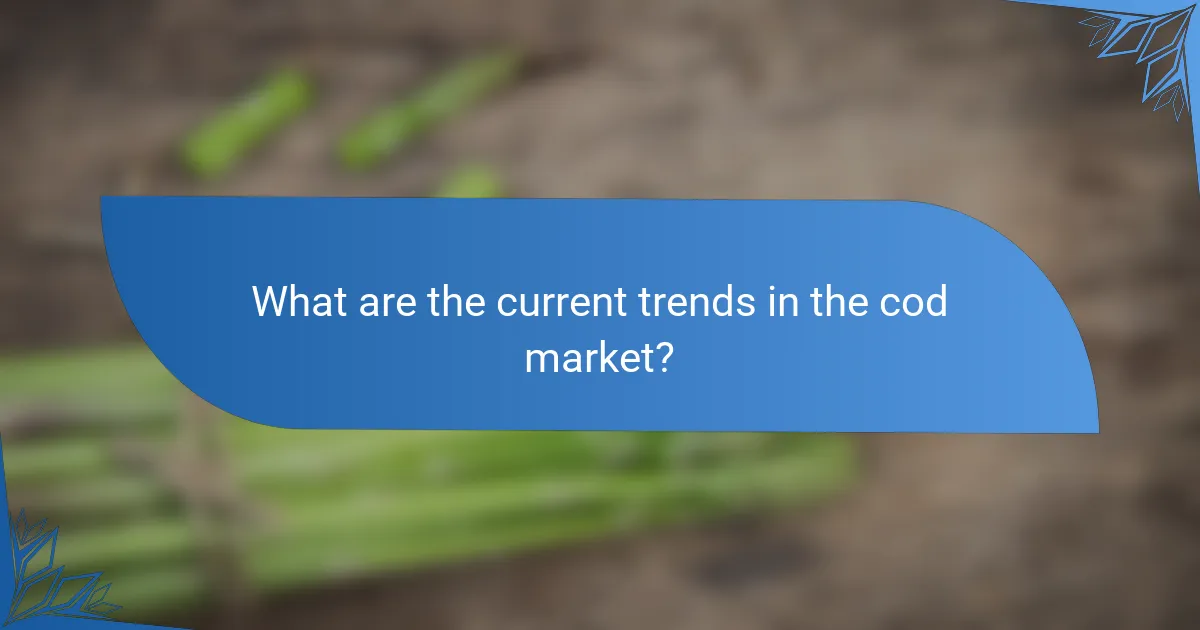
What are the current trends in the cod market?
Current trends in the cod market include increasing demand for sustainable sourcing and higher prices due to limited supply. Consumers are prioritizing eco-friendly fishing practices. This trend is driven by rising awareness of overfishing and environmental impacts. Additionally, there is a shift towards frozen cod products over fresh ones. This change is influenced by convenience and longer shelf life. Regional variations also affect pricing, with North Atlantic cod experiencing different market dynamics than Pacific cod. The overall market reflects a growing emphasis on sustainability and responsible consumption.
How are technological advancements influencing cod pricing?
Technological advancements are significantly influencing cod pricing by improving fishing efficiency and supply chain management. Innovations such as advanced sonar technology enhance fish detection, leading to higher catch rates. This increase in supply can drive prices down due to market saturation. Moreover, automation in processing and packaging reduces labor costs, further affecting pricing structures. Data analytics tools enable better forecasting of market demand, allowing suppliers to adjust prices proactively. According to the Food and Agriculture Organization, technology-driven fishing practices can increase yield by up to 30%. Thus, the integration of technology in the cod industry directly impacts pricing dynamics.
What innovations are being adopted in cod fishing and processing?
Innovations in cod fishing and processing include the use of advanced tracking technologies. These technologies enhance the efficiency of locating fish schools. Smart nets equipped with sensors are also being developed. They help in reducing bycatch and improving selectivity.
Aquaculture techniques are gaining traction for sustainable cod production. These methods aim to alleviate pressure on wild stocks. Processing innovations involve automated filleting and packaging systems. They increase processing speed and reduce labor costs.
Sustainability certifications are becoming essential in the market. They ensure that fishing practices meet environmental standards. These innovations collectively aim to enhance the cod supply chain’s efficiency and sustainability.
How do these technologies affect pricing strategies?
Technologies significantly influence pricing strategies in the cod market. They enable more accurate demand forecasting, which helps set optimal prices. Advanced analytics allow businesses to analyze market trends and consumer behavior effectively. This data-driven approach leads to dynamic pricing models that adjust in real-time. Technologies also enhance supply chain efficiency, reducing costs and allowing for competitive pricing. For instance, blockchain technology improves traceability, which can justify premium pricing for sustainably sourced cod. Overall, these technologies create a more responsive pricing strategy that aligns with market conditions.
What future predictions can be made about cod pricing?
Future predictions for cod pricing indicate a potential increase due to declining fish stocks. Overfishing and environmental changes are impacting supply levels. As demand for cod remains high, prices may rise further. Historical data shows that cod prices have increased by approximately 20% over the past five years. Sustainability practices could influence pricing as consumers prefer responsibly sourced fish. Regulatory measures may also affect availability and cost. Additionally, global market trends and trade policies will play a significant role in future pricing dynamics.
What factors could lead to changes in cod pricing in the next decade?
Changes in cod pricing in the next decade could be influenced by several factors. Overfishing and stock depletion can lead to increased prices due to scarcity. Climate change may alter cod habitats, impacting catch volumes. Regulatory changes aimed at sustainability could restrict fishing quotas, affecting supply. Consumer demand for sustainable seafood is rising, potentially driving prices higher. Economic conditions and inflation will also affect overall pricing in the market. Global trade policies may influence import and export costs, impacting domestic prices. Lastly, advancements in aquaculture could provide alternative sources, stabilizing prices.
How might climate change impact the cod market?
Climate change may significantly impact the cod market by altering fish populations and distribution. Rising ocean temperatures affect the habitats where cod thrive. These changes can lead to decreased cod stocks in traditional fishing areas. In turn, this may drive up prices due to reduced supply. Additionally, shifts in migration patterns may require fishers to travel farther, increasing operational costs. A study by the International Council for the Exploration of the Sea indicates that cod populations in the North Atlantic are declining due to warming waters. This data highlights the potential for economic strain on the cod market as sustainability practices become more essential.
What best practices should consumers follow when purchasing cod?
Consumers should look for sustainably sourced cod when making a purchase. This ensures that the fish is harvested in a way that maintains healthy fish populations and ecosystems. Checking for certifications from organizations like the Marine Stewardship Council (MSC) can guide consumers to responsible choices. Freshness is also critical; consumers should choose cod that has a clean smell and firm texture. Additionally, consumers should inquire about the fish’s origin to ensure it comes from well-managed fisheries. Buying from reputable suppliers increases the likelihood of quality and sustainability. Seasonal availability should be considered, as it often indicates better freshness and lower environmental impact. Lastly, consumers should avoid cod that has been treated with additives or preservatives, as this can affect quality and health.
The main entity of this article is the market pricing of cod, which is influenced by various factors including supply and demand dynamics, seasonal variations, regulatory measures, and consumer preferences. Key insights include how regional variations affect pricing, the impact of sustainability practices on market rates, and the role of certifications in shaping consumer perception. Additionally, the article explores current trends in the cod market, technological advancements affecting pricing strategies, and future predictions regarding pricing changes due to environmental factors and consumer behavior. Understanding these elements is crucial for consumers and businesses to navigate the complexities of cod pricing effectively.
